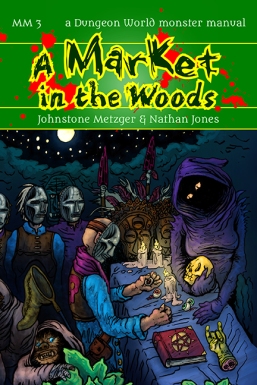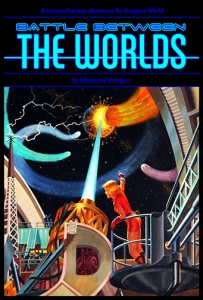Lots of people have made adventures and scenarios for Dungeon World other than me. Joe Banner, John Aegard, Josh Mannon, Marshall Miller, just to name a few. There’s adventures in both the Grim Portents and Mondo Sotteraneo magazines, and then there’s fronts and dangers and stuff in Grim World, Inverse World, and Pirate World.
But I have published the most adventures so far. So probably I’ve learned a few things?
Maybe. Here’s what I can think of right now. Or maybe these are, like, my “opinions, maaaaan.” Whichever, you decide.
FRONTS AND DANGERS
A front is just an organizational tool. The real meat is the stuff in a danger: type, impulse, impending doom, and especially the grim portents. Description, cast, custom moves, and stakes are cool and everything but you will do that stuff anyway if you want to and you won’t if you don’t. How you lay out the dangers and their grim portents—the way the DW book shows or some other way—doesn’t really matter, as long as the GM can understand.
SCENES
I like to include suggested scenes with my grim portents. It is one thing to say “the bandits attack the sheriff” on the grim portents list, and it’s another, more useful thing to suggest how and when they might go about doing that. Give the GM ideas, that’s what your adventure is there to do.
LEAVE BLANKS
There is a right way to do this and a wrong way. Don’t leave something blank if you’re just going to have to invent it later. If you leave a blank spot on your dungeon map and then when the PCs get there you still don’t know what’s there, that’s a sub-optimal use of your prep time.
Instead, when you are the GM, you should leave blanks so you can incorporate suggestions and ideas that the other players contribute. If they tell you they are exploring this dungeon because the Sword of Matrivhor is supposed to be there, don’t just ignore that and plow ahead with your Shrine of Klogh dungeon that has nothing to do with swords or Matrivhors. Put the sword in there somewhere, instead of, or in addition to, the stuff you thought up beforehand. Or change it to the Shrine of Matrivhor and have the PCs find it already looted, with the sword missing—and a clue that will help them find out who took it. Then continue adventuring.
Or, leave the treasure blank in your prep and make sure to ask the players why their characters are raiding this dungeon—what great treasure do they believe is located here?
In short: When you ask them for stuff, use that stuff later.
If you’re writing an adventure, though, how do you encourage this?
KEEP EVERYTHING CONNECTED
The point is that it’s not just a collection of random, disparate things. You have a collection of people, places, things, and situations that actually work together, play off each other, and interact in ways that you have already decided on (and hopefully some unexpected ways, too).
So: try to leave blanks in later parts of your adventure, but put questions in the beginning that will generate the information you need to fill in those blanks.
For example, there is a scrying pool in Island of Fire Mountain that shows the PCs what life is like for the people they left behind to come to this tropical island. This is one reason why you are told to ask the players where their characters come from and what things are like back home—so you can show them what has changed.
Another example: PCs go into a dungeon. Ask them what they fear might be down here, or what they expect, or how they feel vulnerable. Ask them what they think the creatures down here are like, from the worms in the earth to the trolls they are trying to rob. Later on, when they fall into the mutagenic pools in the abandoned alchemical laboratory, use their earlier answers to describe how their bodies mutate. They become the things they feared would be down here.
QUESTIONS
Give the GM questions to ask, things to wonder about. Make them somewhat connected to the stuff that you are presenting in the dungeon. This can be a hard thing for many GMs to come up with, so if you give them stuff they can do right away, those questions can become the seeds of inspiration.
WHAT TO DESCRIBE
In general, I make the assumption that the PCs are unfamiliar with what is being described in the adventure—the people, places, and things—so I try to describe all the stuff that I think is important. The world around the adventure is what I leave up to the GM to either invent or to ask the players about. I also try to include options for the PCs being familiar with the people, places, and things in the adventure, but this is not my default, mainly because this is a fantasy game, so dungeoncrawling and monster fighting and chasing after fleeing thieves are going to be more common than family infighting and small-town romantic shenanigans.
A few other tips:
MONSTERS
The goons at the Something Awful forums decided to add tactics to the monster stat blocks, and this is a good idea. One instinct and some moves alone don’t always tell you what lengths a monster is willing to go to, when they might decide to turn and flee, or what would motivate them to attack the PCs in the first place. Listing tactics beneath their moves is a succinct way to communicate this info. Also, if you put NPCs in your adventure (monsters or people) you should probably give them a motivation of some kind, so the GM doesn’t have to invent one. The GM’s job should be to role-play the how, and spend less time inventing the what, which is why she bought your adventure, after all.
SPOUT LORE RESULTS
Joe Banner puts little sidebars in his adventures, with interesting and useful pieces of information that might be the results of the PCs spouting lore about the things they encounter. This is a good idea! I didn’t do this in any of my adventures, but I should have.
This works better for spout lore than it does for discern realities, I should add. Discern realities results should be right there in a description of the location or situation, but spout lore results can come from sources far afield. Also, if you have answers ready and don’t have to do too much thinking, it encourages players to use spout lore more often, because they know they can count on it actually being useful.
KNOW WHERE TO CUT CORNERS
I’ve written this mostly of these assuming you want to write adventures for other people to use, but these are also tips you can use for your own adventures. If you’ve run even just a few of your own adventures or DW campaigns, you probably have a good idea of what you find easy to improvise during a game and what you probably need to prep for. So skip the tips that don’t help you do that prep. Most of these things don’t really rely on each other.
 In the city of Neth, the painter Bashir al-Barati has not been seen for several days. His house is said to be haunted, as is the abandoned market that lies beneath it. Will a party of brave adventurers destroy the nightmare incursions before they spread further, or will the city fall to corruption?
In the city of Neth, the painter Bashir al-Barati has not been seen for several days. His house is said to be haunted, as is the abandoned market that lies beneath it. Will a party of brave adventurers destroy the nightmare incursions before they spread further, or will the city fall to corruption?




 A small island in the South Seas. A lone fort plagued by cannibal hordes and a race of monsters. A ship, wrecked on the rocks of the far shore, missing all its crew and passengers. An ancient city that stands in ruins, guarded by the very elements themselves, and rumoured to be full of ghosts. All this and more lie waiting for a band of intrepid adventurers. Will they bring peace and prosperity to the island, or merely line their pockets? Will they discover the secret of the lost city of Kuna Lii, or will they leave the entire world in ruins in the attempt? Come ashore, and find out for yourself!
A small island in the South Seas. A lone fort plagued by cannibal hordes and a race of monsters. A ship, wrecked on the rocks of the far shore, missing all its crew and passengers. An ancient city that stands in ruins, guarded by the very elements themselves, and rumoured to be full of ghosts. All this and more lie waiting for a band of intrepid adventurers. Will they bring peace and prosperity to the island, or merely line their pockets? Will they discover the secret of the lost city of Kuna Lii, or will they leave the entire world in ruins in the attempt? Come ashore, and find out for yourself! What’s the adventure about?
What’s the adventure about?